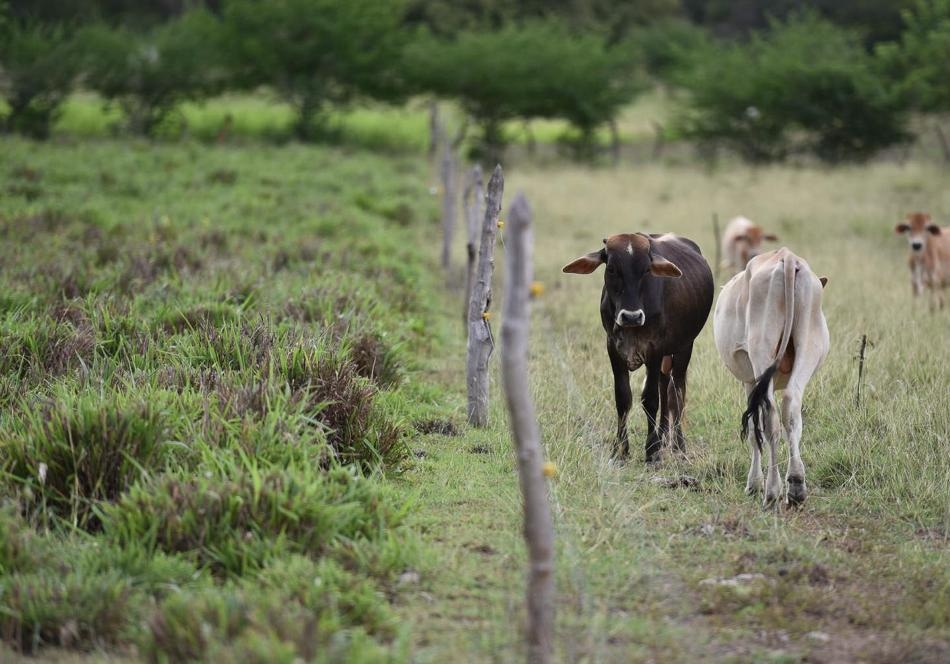Jan 30 2019
The extraordinary climate-altering capabilities of cattle are primarily because of methane, which they release into the atmosphere during their regular digestive routine. Not many know that cattle urine is a climate offender.
 An electrified fence separates cattle on a degraded pasture from a healthier pasture with improved forage grasses. (Image credit: Neil Palmer/CIAT)
An electrified fence separates cattle on a degraded pasture from a healthier pasture with improved forage grasses. (Image credit: Neil Palmer/CIAT)
It creates nitrous oxide (N2O), which has warming power a lot greater than that of carbon dioxide (CO2), the key driver of global warming. A research carried out by the International Center for Tropical Agriculture (CIAT) and collaborators reveals that these N2O emissions can be considerably curtailed by healthy cattle pastures.
For the research, scientists collected cattle urine at research sites in five countries spread throughout Latin America and the Caribbean. They trickled 500 mL samples on paired cattle fields categorized as healthy or degraded, which was established by vegetation coverage. Degraded pastures, in six of the seven test sites, released considerably more N2O—occasionally up to three times as much. The results can be seen in the January 29th issue of Scientific Reports, an open-access journal by the publishers of Nature.
Degraded pastures are bad in so many ways. This study adds to the case for land restoration. Degraded pastures not only affect food security and the livelihood of farmers today, but affects the livelihood of future farmers because they emit more gases that cause global warming.
Ngonidzashe Chirinda, Study’s Lead Author and Researcher, CIAT
The results give a sense of urgency to global land restoration agreements, including Initiative 20x20, which plans on bringing into restoration 20 million hectares of land into restoration in Latin America by 2020 as a first huge step toward even more robust restoration targets.
Although estimates differ, Chirinda calculates, conservatively, that there are 150 million hectares of degraded lands in Latin America. Brazil alone has about 80 million hectares of degraded pastureland.
Degraded livestock land is commonly characterized by loss of organic material, soil compaction, overgrazing, and low levels of nutrients and soil carbon. Large-scale land restoration with rotational grazing, enhanced forage grasses, and the addition of trees and shrubs (silvopastoral farming) could considerably lessen the negative climate effects brought on by degradation. Besides decreasing N2O emissions, restored landscapes usually contain more carbon, more strong and productive livestock, and have healthier soils.
“This study highlights the importance of avoiding land degradation in the first place,” said Todd Rosenstock, a co-author based at World Agroforestry (ICRAF). “Maintaining healthy pastures appears to reinforce goals of both the United Nations’ Framework Convention on Climate Change and the UN Convention to Combat Desertification simultaneously.”
The intriguing results from the single test site that did not match with the study results—in Taluma, Colombia—may be credited to several factors that merit additional research. N2O emissions were by far the least at any test site and were the same on both healthy and degraded pastures. The cattle urine used in the study had the lowest nitrogen content than the other research sites, which probably contributed to the outcomes. The forage grass used there, Brachiaria humidicola, also has a particularly high nitrification inhibition capacity, meaning that it prevents nitrogen from turning into N2O.
Power of data from far-flung places
The research is a plus point for well-organized, modest-budget science. The project started with a weeklong training conference at CIAT headquarters in Cali, Colombia, where a group of PhD students from the additional participating countries—Nicaragua and Trinidad, Brazil, Argentina, and Tobago—helped put together the study plan and standardized the methodology of the study.
The students went back to their home countries and performed the experiment to concur with their area’s rainy seasons, to assure similar climate conditions across research sites. (Taluma was an exception as it was sampled during a period of low rainfall, which is also another probable reason why the N2O emissions were lesser there).
“The power is in the number of data points from all the different countries,” said Chirinda.
Better cattle greenhouse gas estimates
Scientists said the research is a beneficial step toward forming a more comprehensive picture of the possibility of greenhouse gas emissions from cattle farming in LAC.
“Since work on emissions from livestock in the region is not common, this study generates at least one piece of information that is missing from theoretical greenhouse gas estimates in the LAC region,” said Miguel Andrés Arango, a co-author and scientist at Colombia’s AGROSAVIA, the country’s largest agriculture research organization.
Being able to estimate the real impact of cattle production will allow us to propose potential practices for reducing emissions. It is high time we know the emission factors for our agricultural systems.
Miguel Andrés Arango, Study Co-Author and Scientist, AGROSAVIA, Colombia